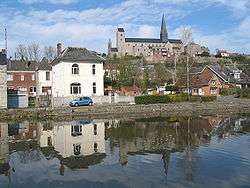Lobbes Abbey
Lobbes Abbey was a Benedictine monastery in Lobbes in Hainaut, Belgium. The abbey played an important role in the religious, political and religious life of the Prince-Bishopric of Liège, especially around the year 1000. In addition to its founder St Landelin, 4 other saints are said "of Lobbes".[1]
History
Foundation

.jpg)

The early history of Lobbes Abbey is known in relative detail because fortunately, and unlike with most abbeys, the ancient annals survived.[2] The monastery was founded by Saint Landelin around 650. Landelin was a young man from a well-to-do family in Bapaume, who lived a sinful life as the head of a band of brigands. After repenting, he founded a monastery at the place where he had committed his sins, at the shores of the river Sambre. The number of monks at the new monastery increased rapidly and the founder grew tired of his duties as an abbot, so in 680 he resigned from his post and dedicated the rest of his life to the worship of God.
Early fame
Landelin was succeeded by Ursmar (Saint Ursmarus) who devoted himself to preaching Christianity among the largely pagan Franks. The fame of Saint Ursmarus and his successors Ermin of Lobbes, Abel of Reims and Theodulph of Lobbes, made Lobbes the most important monastery in Belgium of the time. Under Anson, the 6th abbot (776-800), the abbey school rose to great fame.
In 864 Hucbert, brother-in-law of Lothair II of Lotharingia, became lay abbot. Through his decadent lifestyle he almost brought the monastery to destitution. His successor, Franco, was both abbot of Lobbes and bishop of Liège, a situation that continued until 960. The abbey basically became a fief of the Bishop of Liège, although ecclesiastically it was situated in the bishopric of Cambrai.
In 954 the abbey was raided and burned during the Hungarian invasions of Europe.
Under the abbots Folcuin (965-990), Heriger of Lobbes (990-1007) and Hugo (1033–1053), the abbey and the school once again attained a great reputation.
Decline
After this period the fame of the abbey gradually declined, until the monastic revival originating from the Bursfelde Congregation brought fresh life in the 15th century. In 1569 Lobbes, St. Vaast's Abbey in Arras, and several other abbeys, were combined to form the Benedictine Congregation of Exempt Monasteries of Flanders.
Dissolution
In 1794, the last abbot, Vulgise de Vignron, and 43 monks were expelled from the monastery by French revolutionary troops. Under the law of 2 September 1796 the abbey was dissolved. Most of the monastic buildings, including the abbey church of Saint Peter, were destroyed. The former burial church of Saint Ursmarus survived as a parish church. A few other minor buildings were later incorporated into a railway station.
Art historical significance
The church of Saint Ursmarus is one of the oldest churches in Belgium. The oldest parts date from Carolingian or Ottonian times. The choir and crypt are Romanesque and stand out by their simplicity. The crypt contains the tombs of Saint Ursmarus and Saint Erminus, as well as tombstones from other abbots. The westwork tower is a typical example of Mosan architecture. The pointed spire was added in the 19th century.
From 1865 until 1870 the church was restored by the architect Eugène Carpentier, who basically rebuilt large sections of the church and removed all traces of earlier situations.
Today the Abbey library stored a copy of "Lobbes Bible" completed in 1084 AD and a digitized copy is available on line at IRHT (see Lobbes Bible).
 St Ursmarus church
St Ursmarus church- Church tower
 Church interior
Church interior Romanesque architecture
Romanesque architecture
See also
| Wikimedia Commons has media related to Lobbes Abbey. |
- List of Merovingian monasteries
- Carolingian architecture
- Mosan art
- Regional characteristics of Romanesque architecture
Notes
- http://catholicsaints.info/lobbes-abbey/
- the Annales Laubicenses, printed in G. H. Pertz, Monumenta Germaniae Historica: Scriptores
References
- Vos, Joachim (1865). Lobbes, son abbaye et son chapitre, ou histoire complète du monastère de Saint-Pierre à Lobbes et du Chapitre de Saint-Ursmer à Lobbes et à Binche: avec cartes, vues et portraits (in French). Ch. Peeters.
![]()